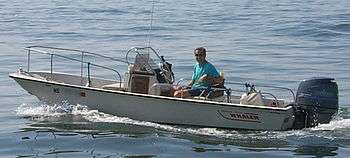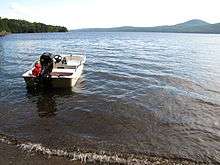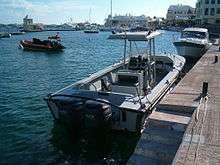Boston Whaler
|
| |
| Founded | June 5, 1958 |
|---|---|
| Founder | Dick Fisher |
| Headquarters | Edgewater, Florida, United States |
| Products | Fiberglass boats |
| Parent | Brunswick Boat Group |

Boston Whaler is an American boat manufacturer located in Florida. It is operated as a subsidiary of the Brunswick Boat Group, a division of the Brunswick Corporation. Boston Whalers were originally manufactured in Massachusetts, but are currently manufactured in Edgewater, Florida.
History
Dick Fisher graduated from Harvard University in 1936. He ran a company building small, lightweight boats out of balsa wood. He designed a rowboat and got the materials to build it, but he never completed it.
In the 1950s, polyurethane foam, a stiff, lightweight, buoyant material, was invented. Fisher imagined it as a replacement for the lightweight balsa pine used in small boat construction, and in 1954 he constructed a small sailing dinghy filled with the foam, with a design similar to the Sunfish. He showed the finished product to his friend, naval architect C. Raymond Hunt. Hunt recognized potential in the process, however he did not feel the design was particularly suited to sailboats. Instead, he created a design based on the Hickman Sea Sled featuring a cathedral hull.
Fisher built a prototype out of Styrofoam and epoxy. "It had two keels," said Fisher, "one inverted V between the runners and an anti-skid, anti-trip chine." Fisher tested the boat all that summer and thought it was “the greatest thing ever”. That fall, Fisher started running the boat in rough weather, and found that the hull displayed issues with handling and cavitation. Under heavy load, and off-plane, the cavity in the middle of the hull forced air into the water, and then back into the prop. Fisher approached Hickman, the original designer of the Sea Sled for a solution. However, Hickman thought his design needed no modifications. Fisher contemplated putting "some stuff on the bottom to move that airy water out of there." He used a method of trial and error, laying fiberglass on the bottom of the hull in the morning and running the boat behind his house when the glass cured. If the design did not work, he would bring it back to his house and start over.
This prototype boat began to have a slight V bottom and the two runners on the sides. Fisher then approached Hunt to examine the design changes. Hunt added his own design changes to the prototype; most notably, a third runner in the center of the hull. Fisher then built a prototype based on this new design to serve as a plug for the production mold.
Fisher and Hunt then took the boat on sea trials. One of these tests was to run the 13 foot boat from Cohasset, Massachusetts to New Bedford and back, which is roughly 120 miles. During these sea trials, Fisher found another small flaw in the boats design: it was "wetter than hell." "A lot wetter," he said, "than the other boat had been." The reason for this, was ostensibly nine inch sole that was throwing all the spray into the boat. Since the mold was already made, it was modified by adding to the flat center between the three chines, turning it into a V shape. In 1956, this design became the original Boston Whaler 13.
In 1958, boats made by the Fisher-Pierce manufacturing company were first marketed and sold under the brand name Boston Whaler. The boat was very stable and had great carrying capacity. These two features, along with great performance and rough weather handling made it very desirable. Also since the Whaler was so light in weight compared to the other boats at the time, it could be propelled by lower horsepower engines.[1] Thru the late 1980s, the classic 13'4" Whaler, and the 16'7" Montauk were the most popular models in terms of sales. Gradually though the company moved away from these designs to a more conventional deep-vee hull, and after 1996 no more of the classic tri-hull boats were manufactured.
In 1969 the Boston Whaler boat operation of Fisher-Pierce was sold to the CML Group, whose portfolio would eventually include brands such as NordicTrack and The Nature Company. In 1989, amidst financial problems, the CML Group sold Boston Whaler to the Reebok Corporation, where, despite several advertising campaigns and new hull designs, it did relatively poorly, and was sold to Meridian Sports in 1994. Two years later in 1996 Brunswick Corporation purchased Boston Whaler for $27.4 million in cash and debt.
Users

While Boston Whalers are primarily seen as recreational boats, Brunswick Boats maintains a commercial division that sells Boston Whalers to coast guard and naval units worldwide. Boston Whalers were used in the Vietnam War by both the Navy SEALs and the United States Coast Guard in rescue and river patrol missions.[2] "The unique Boston Whaler boat has attracted an intensely loyal group of owners and fans."[3] Active discussion forums on the web attest to the broad allegiance to the brand.[4] It is used for sport fishing, water skiing, as a runabout, and as a tender on larger yachts. The Bolivian Naval Force (a land locked country) has 32 Boston Whalers in their fleet.
Current models
Current production models range in length from 9 to 42.5 feet (2.7 to 13.0 meters). Brunswick also owns Mercury Marine; as a result, new Boston Whalers, like all other Brunswick boats, ship from the factory already equipped with Mercury engines. Models include:
| Name | Length | Layout | Min HP | Max HP |
|---|---|---|---|---|
| Sport | 11 feet (3.4 m) | Skiff | 5 | 25 |
| Tender | 11 feet (3.4 m) | Skiff | 5 | 15 |
| Super Sport | 13 feet (4.0 m) | Skiff | 25 | 40 |
| Super Sport | 15 feet (4.6 m) | Skiff | 40 | 60 |
| Super Sport | 17 feet (5.2 m) | Skiff | 40 | 90 |
| Montauk | 15 feet (4.6 m) | Center Console | 40 | 60 |
| Montauk | 17 feet (5.2 m) | Center Console | 80 | 100 |
| Montauk | 19 feet (5.8 m) | Center Console | 90 | 135 |
| Dauntless | 18 feet (5.5 m) | Center Console | 135 | 150 |
| Dauntless | 20 feet (6.1 m) | Center Console | 150 | 200 |
| Dauntless | 23 feet (7.0 m) | Center Console | 225 | 250 |
| Outrage | 19 feet (5.8 m) | Center Console | 115 | 200 |
| Outrage | 22 feet (6.7 m) | Center Console | 135 | 225 |
| Outrage | 24 feet (7.3 m) | Center Console | 225 | 400 |
| Outrage | 27 feet (8.2 m) | Center Console | 400 | 450 |
| Outrage | 32 feet (9.8 m) | Center Console | 400 | 600 |
| Outrage | 32 feet (9.8 m) | Cuddy Cabin | 400 | 600 |
| Outrage | 37 feet (11 m) | Cuddy Cabin | 750 | 900 |
| Outrage | 42 feet (13 m) | Cuddy Cabin | 895 | 1,249 |
| Conquest | 20 feet (6.1 m) | Cuddy Cabin | 135 | 200 |
| Conquest | 23 feet (7.0 m) | Cuddy Cabin | 175 | 250 |
| Conquest | 25 feet (7.6 m) | Cuddy Cabin | 250 | 450 |
| Conquest | 28 feet (8.5 m) | Cuddy Cabin | 300 | 450 |
| Conquest | 30 feet (9.1 m) | Cuddy Cabin | 400 | 600 |
| Conquest | 34 feet (10 m) | Center Console | 550 | 750 |
| Conquest | 34 feet (10 m) | Cuddy Cabin | 550 | 750 |
| Name | Based On | Length | Layout | Min HP | Max HP |
|---|---|---|---|---|---|
| Guardian | Montauk | 15 feet (4.6 m) | Center Console | 40 | 60 |
| Guardian | Montauk | 17 feet (5.2 m) | Center Console | 80 | 100 |
| Guardian | Outrage | 18 feet (5.5 m) | Center Console | 90 | 200 |
| Guardian | Outrage | 19 feet (5.8 m) | Center Console | 115 | 200 |
| Guardian | Outrage | 22 feet (6.7 m) | Center Console | 85 | 240 |
| Guardian | Outrage | 25 feet (7.6 m) | Center Console | 115 | 300 |
| Guardian | Outrage | 27 feet (8.2 m) | Center Console | 300 | 600 |
| Justice | Conquest | 20 feet (6.1 m) | Center Console | 135 | 250 |
| Justice | Conquest | 24 feet (7.3 m) | Center Console | 200 | 400 |
| Justice | Conquest | 27 feet (8.2 m) | Center Console | 400 | 500 |
| Justice | Conquest | 32 feet (9.8 m) | Center Console | 400 | 600 |
| Justice | Conquest | 37 feet (11 m) | Center Console | 750 | 900 |
| Challenger | Conquest | 27 feet (8.2 m) | Cuddy Cabin | 300 | 600 |
| Challenger | Conquest | 35 feet (11 m) | Cuddy Cabin | 300 | 600 |
| Vigilant | Conquest | 27 feet (8.2 m) | Cuddy Cabin | 400 | 450 |
Advertising and unsinkability claim

Boston Whaler has, for many years, sawn boats in half to illustrate their durability, performance, smooth ride and "unsinkability". The original 1961 Life magazine ad pictured Dick Fisher sitting in a floating 13' Whaler with a crosscut saw halfway through the hull.[5] After the cut was completed, Fisher used the stern section to tow the bow section back to shore. Modern Whaler advertising uses a chain saw. Due to the foam core construction, the Whaler will remain afloat when sawed completely in half.[6] Boston Whaler boats also remain afloat when completely swamped (full of water). Because of these attributes, Boston Whaler's trademarked sales line is "the unsinkable legend."
Today, this "unsinkable" attribute is not exclusive to Boston Whalers. All motorboats (and certain other boat types) under twenty (20) feet, manufactured for sale in the United States are required by law to have positive flotation, such that a completely swamped boat will still float.[7] This is accomplished through the use of closed cell foam, or other non-permeable material. Boston Whaler, however, does claim to exceed the Coast Guard requirements.[8]
Further demonstrations have been done to prove how "unsinkable" the boats are. In March 2007, a 19' Guardian was shot with 7.62mm rounds from an M60 machine gun. The boat did not sink, although it was full of holes. The engine was destroyed during the test.

See also
References
- ↑ "continuous Wave: Whaler (Boston Whaler)". Retrieved 2011-08-04.
- ↑ "Patrol Craft Sold for Export". Archived from the original on 2006-05-09. Retrieved 2006-06-24.
- ↑ "continuous Wave: Whaler (Boston Whaler)". Retrieved 2007-06-24.
- ↑ "Boston Whaler Forum". Retrieved 2010-08-12.
- ↑ Hebert, Jim (February 2000). "Original Design and Conception of the 13-foot Whaler Hull". continuouswave.com. Retrieved 2006-06-09.
- ↑ "Boston Whaler Was Always Ahead of Its Time". Retrieved 2014-08-10.
- ↑ "Boatbuilder's Handbook — Flotation". U.S. Coast Guard. Archived from the original on 2006-09-09. Retrieved 2006-09-19.
- ↑ "Boston Whaler". Boston Whaler, Inc. Retrieved 2007-06-24.
External links
| Wikimedia Commons has media related to Boston Whalers. |